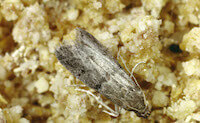WHAT DO cocoa/tobacco MOTHS LOOK LIKE

The adult cocoa moth, Ephestia elutella, is also known as the Tobacco Moth, warehouse moth, and several other common names. No matter what you call them, they’re common to find in the food industry. This is a small, inconspicuous Pyralid moth, measuring about one centimeter in length and up to two centimeters in wingspan. Their slightly shiny wings are brown-gray and streaked with a few dark horizontal stripes. The hind wings are a little lighter, a little silvery, and adorned with a fringed edge. However, they are not very conspicuous and are often overlooked as little grey fliers until they show you the numbers they can create! The larvae, which are what’s usually found in the food, are small caterpillars measuring up to 15 millimeters long in size. They are creamy yellow with a dark head. However, the color of the body can vary depending on the food they are eating. You’ll be more likely to see the adult moths flying or webbed cocoons on the sides of cargo rather than the larvae themselves.